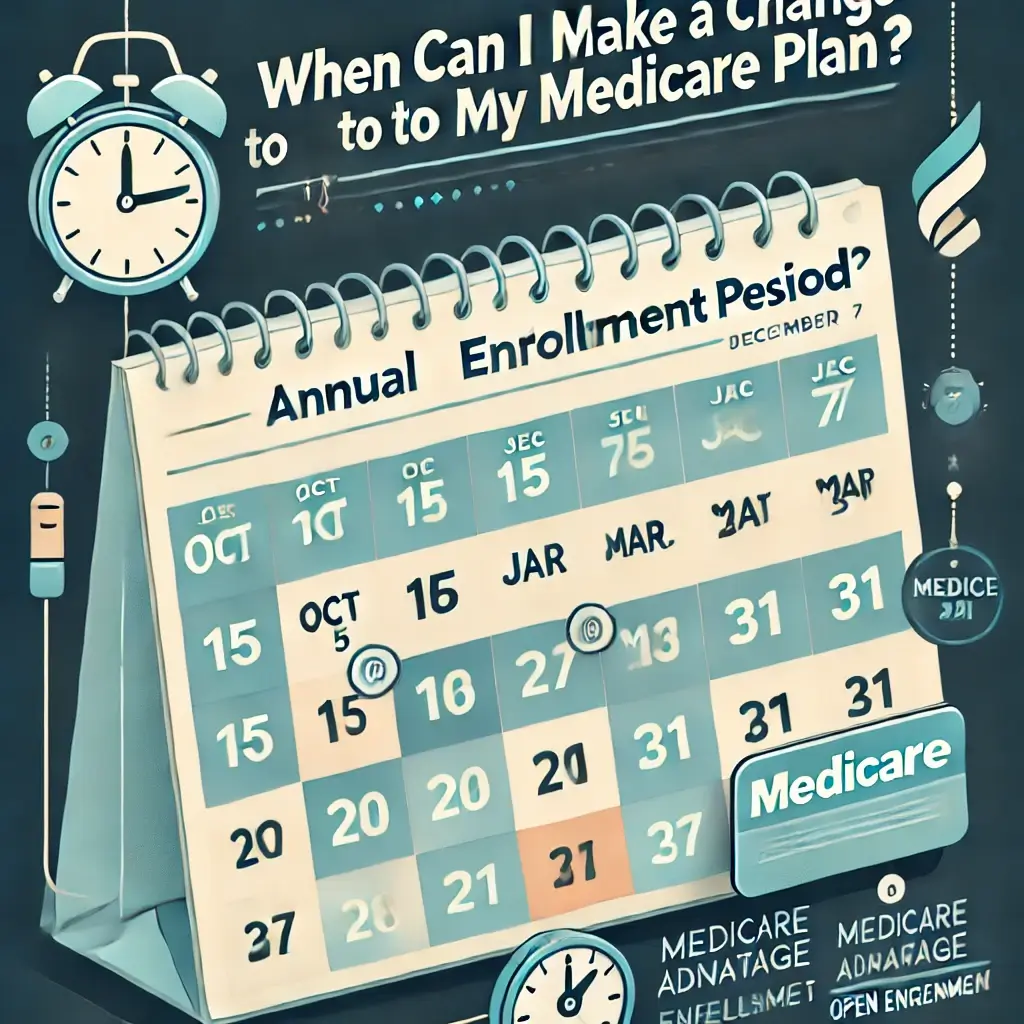Medicare offers important coverage for millions of Americans, but your needs and circumstances may change over time. Whether you want to switch plans, adjust your coverage, or enroll in a new option, knowing when and how you can make changes to your Medicare plan is crucial. Let’s explore the key periods when you can modify your Medicare plan to ensure it continues to meet your healthcare needs.
Key Times to Change Your Medicare Plan
- Annual Enrollment Period (AEP)
Dates: October 15 – December 7
The Annual Enrollment Period, also known as the Medicare Open Enrollment Period, is the most common time to make changes to your Medicare plan. During AEP, you can:- Switch from Original Medicare (Parts A & B) to a Medicare Advantage Plan (Part C).
- Change from one Medicare Advantage Plan to another.
- Switch from a Medicare Advantage Plan back to Original Medicare.
- Enroll in, switch, or drop a Medicare Part D (prescription drug) plan.
- Medicare Advantage Open Enrollment Period
Dates: January 1 – March 31
This period is for those already enrolled in a Medicare Advantage plan. You can:- Switch to another Medicare Advantage Plan.
- Return to Original Medicare (and, if needed, enroll in a Part D prescription drug plan).
- Special Enrollment Period (SEP)
Special Enrollment Periods allow you to make changes to your Medicare plan outside of the standard enrollment periods if you experience certain life events. You may qualify for an SEP if:- You move to a new area that’s outside your plan’s service area.
- You lose your current healthcare coverage (e.g., employer or union health coverage).
- You qualify for Medicaid or Extra Help with prescription drug costs.
- You’re leaving or entering a long-term care facility.
- Initial Enrollment Period (IEP)
Dates: 3 months before your 65th birthday to 3 months after your 65th birthday
If you’re new to Medicare, the Initial Enrollment Period is your first opportunity to enroll in Medicare Parts A, B, C, and D. During this seven-month window, you can:- Sign up for Original Medicare (Parts A & B).
- Enroll in a Medicare Advantage Plan.
- Add a Medicare Part D prescription drug plan.
- General Enrollment Period (GEP)
Dates: January 1 – March 31
If you didn’t sign up for Medicare during your Initial Enrollment Period and aren’t eligible for a Special Enrollment Period, the General Enrollment Period is when you can enroll in Medicare Parts A and B. Coverage begins on July 1 of that year, and late enrollment penalties may apply if you delayed enrollment without qualifying for a Special Enrollment Period. - 5-Star Special Enrollment Period
Dates: December 8 – November 30
Medicare assigns star ratings to Medicare Advantage and Part D plans based on their performance and customer satisfaction. If a 5-star Medicare Advantage Plan or Part D plan is available in your area, you can switch to that plan once per year during this period.
Why Should You Consider Changing Your Medicare Plan?
There are several reasons why you might want to change your Medicare plan:
- Your healthcare needs have changed: If you’ve been diagnosed with a new condition or need different medications, your current plan may no longer be the best fit.
- Your current plan’s costs have increased: Premiums, deductibles, and copayments can change each year. If your plan’s costs have increased significantly, switching plans could save you money.
- New plans or benefits are available: New Medicare Advantage or Part D plans may offer better coverage, lower costs, or additional benefits like dental, vision, or fitness programs.
How to Change Your Medicare Plan
If you decide to make a change during one of the enrollment periods, follow these steps:
- Compare Plans: Use the Medicare Plan Finder tool on Medicare.gov to compare available Medicare Advantage, Part D, and Medigap plans in your area.
- Enroll in Your New Plan: Once you’ve selected a plan, you can enroll online, over the phone, or by contacting the plan directly.
- Cancel Your Old Plan: When you switch plans, your old plan will typically be automatically canceled once your new coverage starts. If you’re returning to Original Medicare, you may need to notify your Medicare Advantage plan provider.
Conclusion
Understanding when you can make changes to your Medicare plan is key to ensuring you have the right coverage for your needs. Whether it’s during the Annual Enrollment Period, a Special Enrollment Period, or one of the other key windows, knowing your options allows you to adjust your coverage as your healthcare needs evolve. Be sure to review your plan each year and take advantage of the appropriate enrollment periods to keep your coverage aligned with your health and financial goals.


